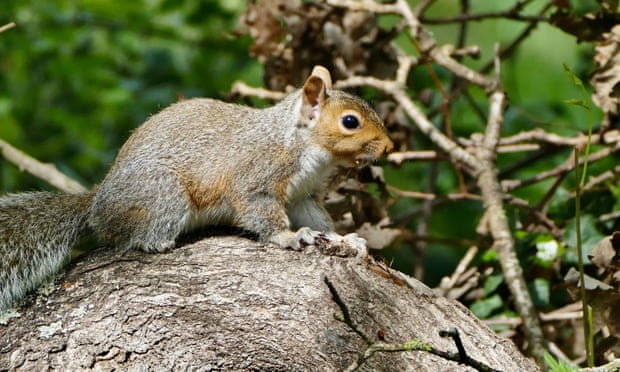August 12, 2021
Twenty forest strongholds in Scotland would save the red squirrel from extinction even if grey squirrels were to colonise the whole of Britain, according to research.
Since their introduction from North America by Victorian enthusiasts, grey squirrels have pushed red squirrels out of much of the country, with reds outcompeted by the bigger greys and also succumbing to the squirrelpox virus carried by the non-native squirrel.
Grey squirrels have not yet penetrated much of the Highlands but new modelling led by Prof Andy White, a mathematical biologist at Heriot-Watt University, suggests that there are at least 20 havens across Scotland where viable populations of reds would remain even if the greys continued to march northwards.
“This is great news for red squirrels,” said White. “When I started this research 10 years ago I was pretty pessimistic about the outcome for red squirrels in Scotland. Now I’m very optimistic. The work done by conservation bodies has prevented the spread of grey squirrels beyond certain boundaries over the last decade.”
The research, which is published in Nature Conservation, identifies havens within existing areas of non-native plantations, such as Eskdalemuir Forest in Dumfries and Galloway in southern Scotland and Newtyle Forest in Moray in the north. Ironically, the native red squirrel can survive in non-native plantations of species such as sitka spruce that are inhospitable for the broadleaved or mixed woodland-loving grey squirrel.
The co-author, Kenny Kortland, a wildlife ecologist for Forest and Land Scotland, the Scottish government’s forestry body, said that the study showed that Scotland’s timber industry supports one of the country’s most popular species.

“This modelling work confirms that forest landscapes managed for timber production create safe havens for viable populations of red squirrels, even if grey squirrel populations were to expand,” he said.
The red squirrel occurs across Europe and Asia and is not in danger of extinction globally, but in Scotland a plan has been drawn up to protect the species if the grey squirrel penetrates the entire country. The study calls into question the current policy to create 19 managed strongholds for the reds in Scotland by removing broadleaf trees from certain forests to make them better for reds and worse for greys.
“This would reduce tree species diversity for other species,” said White. “Our model shows that over 20 existing forests in Scotland would act as natural strongholds for the reds. This means we don’t have to remove broadleaf species like oak. Natural strongholds could conserve red squirrel populations while simultaneously maintaining forest diversity.”
Saving red squirrels via so few strongholds remains a last resort, with grassroots conservation efforts currently directed at killing grey squirrels to protect populations of reds across a much wider area of northern Britain.
The Department for Environment, Food and Rural Affairs is supporting work to assess the effectiveness of oral contraceptives to humanely control grey squirrel populations while there is also some discussion of “gene editing” as a long-term solution to reducing the grey squirrel population.
The resurgence of pine martens has also improved the reds’ prospects, with the native carnivore proving effective at predating or dispersing grey squirrels. But last year a study showed that the pine marten will not live in urban areas, which remain a grey squirrel stronghold from where the species can expand.
This article by Patrick Barkham was first published by The Guardian on 4 August 2021. Lead Image: The red squirrel can survive in non-native plantations that are inhospitable for the grey. Photograph: Danny Lawson/PA.
What you can do
Support ‘Fighting for Wildlife’ by donating as little as $1 – It only takes a minute. Thank you.
Fighting for Wildlife supports approved wildlife conservation organizations, which spend at least 80 percent of the money they raise on actual fieldwork, rather than administration and fundraising. When making a donation you can designate for which type of initiative it should be used – wildlife, oceans, forests or climate.
(Sources: Focusing on Wildlife)












Đăng nhận xét